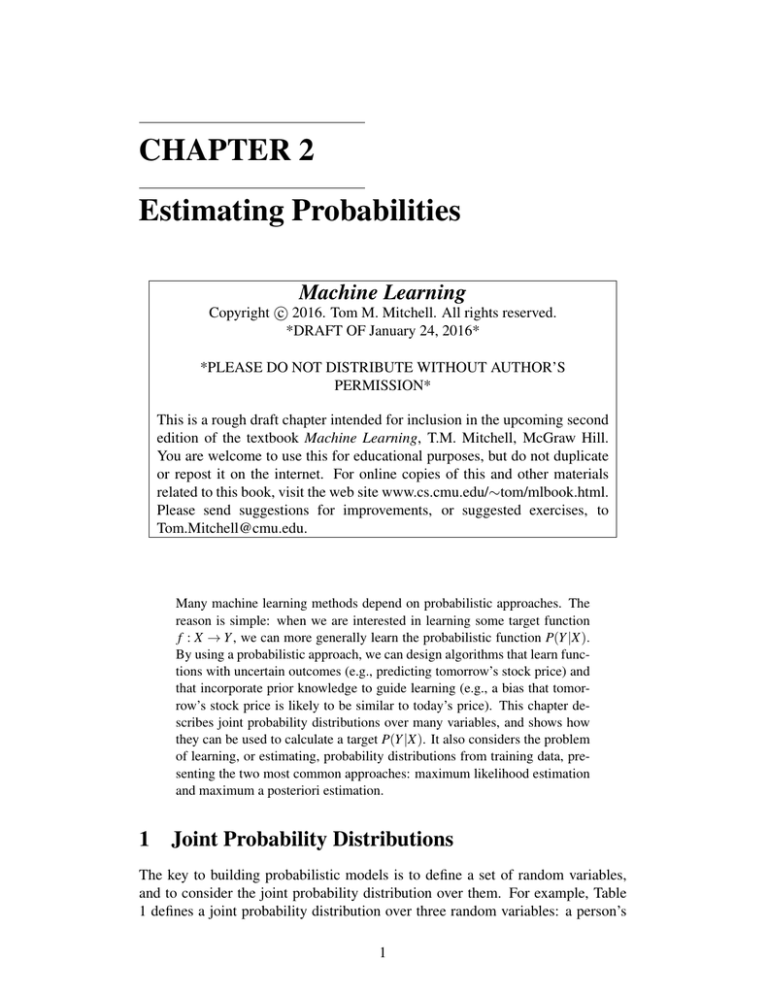
CHAPTER 2
Estimating Probabilities
Machine Learning
c 2016. Tom M. Mitchell. All rights reserved.
Copyright *DRAFT OF January 24, 2016*
*PLEASE DO NOT DISTRIBUTE WITHOUT AUTHOR’S
PERMISSION*
This is a rough draft chapter intended for inclusion in the upcoming second
edition of the textbook Machine Learning, T.M. Mitchell, McGraw Hill.
You are welcome to use this for educational purposes, but do not duplicate
or repost it on the internet. For online copies of this and other materials
related to this book, visit the web site www.cs.cmu.edu/∼tom/mlbook.html.
Please send suggestions for improvements, or suggested exercises, to
Tom.Mitchell@cmu.edu.
Many machine learning methods depend on probabilistic approaches. The
reason is simple: when we are interested in learning some target function
f : X → Y , we can more generally learn the probabilistic function P(Y |X).
By using a probabilistic approach, we can design algorithms that learn functions with uncertain outcomes (e.g., predicting tomorrow’s stock price) and
that incorporate prior knowledge to guide learning (e.g., a bias that tomorrow’s stock price is likely to be similar to today’s price). This chapter describes joint probability distributions over many variables, and shows how
they can be used to calculate a target P(Y |X). It also considers the problem
of learning, or estimating, probability distributions from training data, presenting the two most common approaches: maximum likelihood estimation
and maximum a posteriori estimation.
1
Joint Probability Distributions
The key to building probabilistic models is to define a set of random variables,
and to consider the joint probability distribution over them. For example, Table
1 defines a joint probability distribution over three random variables: a person’s
1
c 2016, Tom M. Mitchell.
Copyright Gender
female
female
female
female
male
male
male
male
HoursWorked
< 40.5
< 40.5
≥ 40.5
≥ 40.5
< 40.5
< 40.5
≥ 40.5
≥ 40.5
2
Wealth probability
poor
0.2531
rich
0.0246
poor
0.0422
rich
0.0116
poor
0.3313
rich
0.0972
poor
0.1341
rich
0.1059
Table 1: A Joint Probability Distribution. This table defines a joint probability distribution over three random variables: Gender, HoursWorked, and Wealth.
Gender, the number of HoursWorked each week, and their Wealth. In general,
defining a joint probability distribution over a set of discrete-valued variables involves three simple steps:
1. Define the random variables, and the set of values each variable can take
on. For example, in Table 1 the variable Gender can take on the value
male or female, the variable HoursWorked can take on the value “< 40.5’
or “≥ 40.5,” and Wealth can take on values rich or poor.
2. Create a table containing one row for each possible joint assignment of values to the variables. For example, Table 1 has 8 rows, corresponding to the 8
possible ways of jointly assigning values to three boolean-valued variables.
More generally, if we have n boolean valued variables, there will be 2n rows
in the table.
3. Define a probability for each possible joint assignment of values to the variables. Because the rows cover every possible joint assignment of values,
their probabilities must sum to 1.
The joint probability distribution is central to probabilistic inference. We can
calculate conditional or joint probabilities over any subset of variables, given their
joint distribution. This is accomplished by operating on the probabilities for the
relevant rows in the table. For example, we can calculate:
• The probability that any single variable will take on any specific value. For
example, we can calculate that the probability P(Gender = male) = 0.6685
for the joint distribution in Table 1, by summing the four rows for which
Gender = male. Similarly, we can calculate the probability P(Wealth =
rich) = 0.2393 by adding together the probabilities for the four rows covering the cases for which Wealth=rich.
• The probability that any subset of the variables will take on a particular joint
assignment. For example, we can calculate that the probability P(Wealth=rich∧
c 2016, Tom M. Mitchell.
Copyright 3
Gender=female) = 0.0362, by summing the two table rows that satisfy this
joint assignment.
• Any conditional probability defined over subsets of the variables. Recall
the definition of conditional probability P(Y |X) = P(X ∧Y )/P(X). We can
calculate both the numerator and denominator in this definition by summing appropriate rows, to obtain the conditional probability. For example,
according to Table 1, P(Wealth=rich|Gender=female) = 0.0362/0.3315 =
0.1092.
To summarize, if we know the joint probability distribution over an arbitrary set of random variables {X1 . . . Xn }, then we can calculate the conditional
and joint probability distributions for arbitrary subsets of these variables (e.g.,
P(Xn |X1 . . . Xn−1 )). In theory, we can in this way solve any classification, regression, or other function approximation problem defined over these variables,
and furthermore produce probabilistic rather than deterministic predictions for
any given input to the target function.1 For example, if we wish to learn to
predict which people are rich or poor based on their gender and hours worked,
we can use the above approach to simply calculate the probability distribution
P(Wealth | Gender, HoursWorked).
1.1
Learning the Joint Distribution
How can we learn joint distributions from observed training data? In the example
of Table 1 it will be easy if we begin with a large database containing, say, descriptions of a million people in terms of their values for our three variables. Given a
large data set such as this, one can easily estimate a probability for each row in the
table by calculating the fraction of database entries (people) that satisfy the joint
assignment specified for that row. If thousands of database entries fall into each
row, we will obtain highly reliable probability estimates using this strategy.
In other cases, however, it can be difficult to learn the joint distribution due to
the very large amount of training data required. To see the point, consider how our
learning problem would change if we were to add additional variables to describe
a total of 100 boolean features for each person in Table 1 (e.g., we could add ”do
they have a college degree?”, ”are they healthy?”). Given 100 boolean features,
the number of rows in the table would now expand to 2100 , which is greater than
1030 . Unfortunately, even if our database describes every single person on earth
we would not have enough data to obtain reliable probability estimates for most
rows. There are only approximately 1010 people on earth, which means that for
most of the 1030 rows in our table, we would have zero training examples! This
is a significant problem given that real-world machine learning applications often
1 Of course if our random variables have continuous values instead of discrete, we would need
an infinitely large table. In such cases we represent the joint distribution by a function instead of a
table, but the principles for using the joint distribution remain unchanged.
c 2016, Tom M. Mitchell.
Copyright 4
use many more than 100 features to describe each example, and that learning such
probability terms is central to probabilistic machine learning algorithms.
To successfully address the issue of learning probabilities from available training data, we must (1) be smart about how we estimate probability parameters from
available data, and (2) be smart about how we represent joint probability distributions.
2
Estimating Probabilities
Let us begin our discussion of how to estimate probabilities with a simple example, and explore two intuitive algorithms. It will turn out that these two intuitive
algorithms illustrate the two primary approaches used in nearly all probabilistic
machine learning algorithms.
In this simple example you have a coin, represented by the random variable
X. If you flip this coin, it may turn up heads (indicated by X = 1) or tails (X = 0).
The learning task is to estimate the probability that it will turn up heads; that is, to
estimate P(X = 1). We will use θ to refer to the true (but unknown) probability of
heads (e.g., P(X = 1) = θ), and use θ̂ to refer to our learned estimate of this true
θ. You gather training data by flipping the coin n times, and observe that it turns
up heads α1 times, and tails α0 times. Of course n = α1 + α0 .
What is the most intuitive approach to estimating θ = P(X =1) from this training data? Most people immediately answer that we should estimate the probability
by the fraction of flips that result in heads:
Probability estimation Algorithm 1 (maximum likelihood). Given
observed training data producing α1 total ”heads,” and α0 total ”tails,”
output the estimate
α1
θ̂ =
α1 + α0
For example, if we flip the coin 50 times, observing 24 heads and 26 tails, then
we will estimate θ̂ = 0.48.
This approach is quite reasonable, and very intuitive. It is a good approach
when we have plenty of training data. However, notice that if the training data is
very scarce it can produce unreliable estimates. For example, if we observe only
3 flips of the coin, we might observe α1 = 1 and α0 = 2, producing the estimate
θ̂ = 0.33. How would we respond to this? If we have prior knowledge about the
coin – for example, if we recognize it as a government minted coin which is likely
to have θ close to 0.5 – then we might respond by still believing the probability is
closer to 0.5 than to the algorithm 1 estimate θ̂ = 0.33. This leads to our second
intuitive algorithm: an algorithm that enables us to incorporate prior assumptions
along with observed training data to produce our final estimate. In particular,
Algorithm 2 allows us to express our prior assumptions or knowledge about the
coin by adding in any number of imaginary coin flips resulting in heads or tails.
We can use this option of introducing γ1 imaginary heads, and γ0 imaginary tails,
to express our prior assumptions:
c 2016, Tom M. Mitchell.
Copyright 5
Probability estimation Algorithm 2. (maximum a posteriori probability). Given observed training data producing α1 observed ”heads,”
and α0 observed ”tails,” plus prior information expressed by introducing γ1 imaginary ”heads” and γ0 imaginary ”tails,” output the estimate
θ̂ =
(α1 + γ1 )
(α1 + γ1 ) + (α0 + γ0 )
Note that Algorithm 2, like Algorithm 1, produces an estimate based on the
proportion of coin flips that result in ”heads.” The only difference is that Algorithm 2 allows including optional imaginary flips that represent our prior assumptions about θ, in addition to actual observed data. Algorithm 2 has several attractive properties:
• It is easy to incorporate our prior assumptions about the value of θ by adjusting the ratio of γ1 to γ0 . For example, if we have reason to assume
that θ = 0.7 we can add in γ1 = 7 imaginary flips with X = 1, and γ0 = 3
imaginary flips for X = 0.
• It is easy to express our degree of certainty about our prior knowledge, by
adjusting the total volume of imaginary coin flips. For example, if we are
highly certain of our prior belief that θ = 0.7, then we might use priors of
γ1 = 700 and γ0 = 300 instead of γ1 = 7 and γ0 = 3. By increasing the
volume of imaginary examples, we effectively require a greater volume of
contradictory observed data in order to produce a final estimate far from our
prior assumed value.
• If we set γ1 = γ0 = 0, then Algorithm 2 produces exactly the same estimate
as Algorithm 1. Algorithm 1 is just a special case of Algorithm 2.
• Asymptotically, as the volume of actual observed data grows toward infinity, the influence of our imaginary data goes to zero (the fixed number of
imaginary coin flips becomes insignificant compared to a sufficiently large
number of actual observations). In other words, Algorithm 2 behaves so
that priors have the strongest influence when observations are scarce, and
their influence gradually reduces as observations become more plentiful.
Both Algorithm 1 and Algorithm 2 are intuitively quite compelling. In fact,
these two algorithms exemplify the two most widely used approaches to machine
learning of probabilistic models from training data. They can be shown to follow
from two different underlying principles. Algorithm 1 follows a principle called
Maximum Likelihood Estimation (MLE), in which we seek an estimate of θ that
maximizes the probability of the observed data. In fact we can prove (and will,
below) that Algorithm 1 outputs an estimate of θ that makes the observed data
more probable than any other possible estimate of θ. Algorithm 2 follows a different principle called Maximum a Posteriori (MAP) estimation, in which we seek
c 2016, Tom M. Mitchell.
Copyright 6
Figure 1: MLE and MAP estimates of θ as the number of coin flips grows. Data was
generated by a random number generator that output a value of 1 with probability θ = 0.3,
and a value of 0 with probability of (1 − θ) = 0.7. Each plot shows the two estimates of θ
as the number of observed coin flips grows. Plots on the left correspond to values of γ1 and
γ0 that reflect the correct prior assumption about the value of θ, plots on the right reflect
the incorrect prior assumption that θ is most probably 0.4. Plots in the top row reflect
lower confidence in the prior assumption, by including only 60 = γ1 + γ0 imaginary data
points, whereas bottom plots assume 120. Note as the size of the data grows, the MLE
and MAP estimates converge toward each other, and toward the correct estimate for θ.
the estimate of θ that is most probable, given the observed data, plus background
assumptions about its value. Thus, the difference between these two principles
is that Algorithm 2 assumes background knowledge is available, whereas Algorithm 1 does not. Both principles have been widely used to derive and to justify
a vast range of machine learning algorithms, from Bayesian networks, to linear
regression, to neural network learning. Our coin flip example represents just one
of many such learning problems.
The experimental behavior of these two algorithms is shown in Figure 1. Here
the learning task is to estimate the unknown value of θ = P(X = 1) for a booleanvalued random variable X, based on a sample of n values of X drawn independently (e.g., n independent flips of a coin with probability θ of heads). In this
figure, the true value of θ is 0.3, and the same sequence of training examples is
c 2016, Tom M. Mitchell.
Copyright 7
used in each plot. Consider first the plot in the upper left. The blue line shows
the estimates of θ produced by Algorithm 1 (MLE) as the number n of training
examples grows. The red line shows the estimates produced by Algorithm 2, using the same training examples and using priors γ0 = 42 and γ1 = 18. This prior
assumption aligns with the correct value of θ (i.e., [γ1 /(γ1 + γ0 )] = 0.3). Note
that as the number of training example coin flips grows, both algorithms converge
toward the correct estimate of θ, though Algorithm 2 provides much better estimates than Algorithm 1 when little data is available. The bottom left plot shows
the estimates if Algorithm 2 uses even more confident priors, captured by twice
as many hallucinated examples (γ0 = 84 and γ1 = 36). The two plots on the right
side of the figure show the estimates produced when Algorithm 2 (MAP) uses incorrect priors (where [γ1 /(γ1 + γ0 )] = 0.4). The difference between the top right
and bottom right plots is again only a difference in the number of hallucinated
examples, reflecting the difference in confidence that θ should be close to 0.4.
2.1
Maximum Likelihood Estimation (MLE)
Maximum Likelihood Estimation, often abbreviated MLE, estimates one or more
probability parameters θ based on the principle that if we observe training data D,
we should choose the value of θ that makes D most probable. When applied to
the coin flipping problem discussed above, it yields Algorithm 1. The definition
of the MLE in general is
θ̂MLE = arg max P(D|θ)
(1)
θ
The intuition underlying this principle is simple: we are more likely to observe
data D if we are in a world where the appearance of this data is highly probable.
Therefore, we should estimate θ by assigning it whatever value maximizes the
probability of having observed D.
Beginning with this principle for choosing among possible estimates of θ, it
is possible to mathematically derive a formula for the value of θ that provably
maximizes P(D|θ). Many machine learning algorithms are defined so that they
provably learn a collection of parameter values that follow this maximum likelihood principle. Below we derive Algorithm 1 for our above coin flip example,
beginning with the maximum likelihood principle.
To precisely define our coin flipping example, let X be a random variable
which can take on either value 1 or 0, and let θ = P(X = 1) refer to the true, but
possibly unknown, probability that a random draw of X will take on the value 1.2
Assume we flip the coin X a number of times to produce training data D, in which
we observe X = 1 a total of α1 times, and X = 0 a total of α0 times. We further
assume that the outcomes of the flips are independent (i.e., the result of one coin
flip has no influence on other coin flips), and identically distributed (i.e., the same
value of θ governs each coin flip). Taken together, these assumptions are that the
2A
random variable defined in this way is called a Bernoulli random variable, and the probability distribution it follows, defined by θ, is called a Bernoulli distribution.
c 2016, Tom M. Mitchell.
Copyright 8
coin flips are independent, identically distributed (which is often abbreviated to
”i.i.d.”).
The maximum likelihood principle involves choosing θ to maximize P(D|θ).
Therefore, we must begin by writing an expression for P(D|θ), or equivalently
P(α1 , α0 |θ) in terms of θ, then find an algorithm that chooses a value for θ that
maximizes this quantify. To begin, note that if data D consists of just one coin flip,
then P(D|θ) = θ if that one coin flip results in X = 1, and P(D|θ) = (1−θ) if the
result is instead X = 0. Furthermore, if we observe a set of i.i.d. coin flips such
as D = h1, 1, 0, 1, 0i, then we can easily calculate P(D|θ) by multiplying together
the probabilities of each individual coin flip:
P(D = h1, 1, 0, 1, 0i|θ) = θ · θ · (1−θ) · θ · (1−θ) = θ3 · (1−θ)2
In other words, if we summarize D by the total number of observed times α1 when
X = 1 and α0 when X = 0, we have in general
P(D = hα1 , α0 i|θ) = θα1 (1−θ)α0
(2)
The above expression gives us a formula for P(D = hα1 , α0 i|θ). The quantity
P(D|θ) is often called the likelihood function because it expresses the probability
of the observed data D as a function of θ. This likelihood function is often written
L(θ) = P(D|θ).
Our final step in this derivation is to determine the value of θ that maximizes
the likelihood function P(D = hα1 , α0 i|θ). Notice that maximizing P(D|θ) with
respect to θ is equivalent to maximizing its logarithm, ln P(D|θ) with respect to θ,
because ln(x) increases monotonically with x:
arg max P(D|θ) = arg max ln P(D|θ)
θ
θ
It often simplifies the mathematics to maximize ln P(D|θ) rather than P(D|θ), as
is the case in our current example. In fact, this log likelihood is so common that it
has its own notation, `(θ) = ln P(D|θ).
To find the value of θ that maximizes ln P(D|θ), and therefore also maximizes
P(D|θ), we can calculate the derivative of ln P(D = hα1 , α0 i|θ) with respect to θ,
then solve for the value of θ that makes this derivative equal to zero. First, we
calculate the derivative of the log of the likelihood function of Eq. (2):
∂ ln P(D|θ)
∂`(θ)
=
∂θ
∂θ
∂ ln[θα1 (1−θ)α0 ]
=
∂θ
∂ [α1 ln θ + α0 ln(1−θ)]
=
∂θ
∂ ln(1−θ)
∂ ln θ
= α1
+ α0
∂θ
∂θ
∂ ln θ
∂ ln(1−θ) ∂(1 − θ)
= α1
+ α0
·
∂θ
∂(1 − θ)
∂θ
∂`(θ)
1
1
= α1 + α0
· (−1)
(3)
∂θ
θ
(1 − θ)
c 2016, Tom M. Mitchell.
Copyright 9
1
∂ ln x
∂x = x ,
∂ f (x) ∂g(x)
∂g(x) · ∂x .
where the last step follows from the equality
∂ f (x)
∂x
and where the next to last
step follows from the chain rule
=
Finally, to calculate the value of θ that maximizes `(θ), we set the derivative
in equation (3) to zero, and solve for θ.
1
1
0 = α1 − α0
θ
1−θ
1
1
α0
= α1
1−θ
θ
α0 θ = α1 (1 − θ)
(α1 + α0 )θ = α1
α1
θ =
α1 + α0
(4)
Thus, we have derived in equation (4) the intuitive Algorithm 1 for estimating
θ, starting from the principle that we want to choose the value of θ that maximizes
P(D|θ).
θ̂MLE = arg max P(D|θ) = arg max ln P(D|θ) =
θ
θ
α1
α1 + α0
This same maximum likelihood principle is used as the basis for deriving many
machine learning algorithms for more complex problems where the solution is not
so intuitively obvious.
2.2
Maximum a Posteriori Probability Estimation (MAP)
Maximum a Posteriori Estimation, often abbreviated to MAP estimation, estimates one or more probability parameters θ based on the principle that we should
choose the value of θ that is most probable, given the observed data D and our
prior assumptions summarized by P(θ).
θ̂MAP = arg max P(θ|D)
θ
When applied to the coin flipping problem discussed above, it yields Algorithm
2. Using Bayes rule, we can rewrite the MAP principle as:
θ̂MAP = arg max P(θ|D) = arg max
θ
θ
P(D|θ)P(θ)
P(D)
and given that P(D) does not depend on θ, we can simplify this by ignoring the
denominator:
θ̂MAP = arg max P(θ|D) = arg max P(D|θ)P(θ)
θ
(5)
θ
Comparing this to the MLE principle described in equation (1), we see that whereas
the MLE principle is to choose θ to maximize P(D|θ), the MAP principle instead
maximizes P(D|θ)P(θ). The only difference is the extra P(θ).
c 2016, Tom M. Mitchell.
Copyright 10
To produce a MAP estimate for θ we must specify a prior distribution P(θ)
that summarizes our a priori assumptions about the value of θ. In the case where
data is generated by multiple i.i.d. draws of a Bernoulli random variable, as in our
coin flip example, the most common form of prior is a Beta distribution:
P(θ) = Beta(β0 , β1 ) =
θβ1 −1 (1 − θ)β0 −1
B(β0 , β1 )
(6)
Here β0 and β1 are parameters whose values we must specify in advance to define
a specific P(θ). As we shall see, choosing values for β0 and β1 corresponds to
choosing the number of imaginary examples γ0 and γ1 in the above Algorithm
2. The denominator B(β0 , β1 ) is a normalization term defined by the function B,
which assures the probability integrates to one, but which is independent of θ.
As defined in Eq. (5), the MAP estimate involves choosing the value of θ that
maximizes P(D|θ)P(θ). Recall we already have an expression for P(D|θ) in Eq.
(2). Combining this with the above expression for P(θ) we have:
θ̂MAP = arg max P(D|θ)P(θ)
theta
= arg max θα1 (1−θ)α0
θ
= arg max
θ
θβ1 −1 (1 − θ)β0 −1
B(β0 , β1 )
θα1 +β1 −1 (1 − θ)α0 +β0 −1
B(β0 , β1 )
= arg max θα1 +β1 −1 (1 − θ)α0 +β0 −1
(7)
θ
where the final line follows from the previous line because B(β0 , β1 ) is independent of θ.
How can we solve for the value of θ that maximizes the expression in Eq. (7)?
Fortunately, we have already answered this question! Notice that the quantity we
seek to maximize in Eq. (7) can be made identical to the likelihood function in Eq.
(2) if we substitute (α1 + β1 − 1) for α1 in Eq. (2), and substitute (α0 + β0 − 1)
for α0 . We can therefore reuse the derivation of θ̂MLE beginning from Eq. (2) and
ending with Eq. (4), simply by carrying through this substitution. Applying this
same substitution to Eq. (4) implies the solution to Eq. (7) is therefore
θ̂MAP = arg max P(D|θ)P(θ) =
θ
(α1 + β1 − 1)
(α1 + β1 − 1) + (α0 + β0 − 1)
(8)
Thus, we have derived in Eq. (8) the intuitive Algorithm 2 for estimating θ,
starting from the principle that we want to choose the value of θ that maximizes
P(θ|D). The number γ1 of imaginary ”heads” in Algorithm 2 is equal to β1 − 1,
and the number γ0 of imaginary ”tails” is equal to β0 − 1. This same maximum
a posteriori probability principle is used as the basis for deriving many machine
learning algorithms for more complex problems where the solution is not so intuitively obvious as it is in our coin flipping example.
c 2016, Tom M. Mitchell.
Copyright 3
11
Notes on Terminology
A boolean valued random variable X ∈ {0, 1}, governed by the probability distribution P(X = 1) = θ; P(X = 0) = (1−θ) is called a Bernoulli random variable,
and this probability distribution is called a Bernoulli distribution. A convenient
mathematical expression for a Bernoulli distribution P(X) is:
P(X = x) = θx · (1−θ)1−x
The Beta(β0 , β1 ) distribution defined in Eq. (6) is called the conjugate prior
for the binomial likelihood function θα1 (1−θ)α0 , because the posterior distribution P(D|θ)P(θ) is also a Beta distribution. More generally, any P(θ) is called the
conjugate prior for a likelihood function L(θ) = P(D|θ) if the posterior P(θ|D) is
of the same form as P(θ).
4
What You Should Know
The main points of this chapter include:
• Joint probability distributions lie at the core of probabilistic machine learning approaches. Given the joint probability distribution P(X1 . . . Xn ) over a
set of random variables, it is possible in principle to compute any joint or
conditional probability defined over any subset of these variables.
• Learning, or estimating, the joint probability distribution from training data
can be easy if the data set is large compared to the number of distinct probability terms we must estimate. But in many practical problems the data
is more sparse, requiring methods that rely on prior knowledge or assumptions, in addition to observed data.
• Maximum likelihood estimation (MLE) is one of two widely used principles
for estimating the parameters that define a probability distribution. This
principle is to choose the set of parameter values θ̂MLE that makes the observed training data most probable (over all the possible choices of θ):
θ̂MLE = arg max P(data|θ)
θ
In many cases, maximum likelihood estimates correspond to the intuitive
notion that we should base probability estimates on observed ratios. For
example, given the problem of estimating the probability that a coin will
turn up heads, given α1 observed flips resulting in heads, and α0 observed
flips resulting in tails, the maximum likelihood estimate corresponds exactly
to taking the fraction of flips that turn up heads:
θ̂MLE = arg max P(data|θ) =
θ
α1
α1 + α0
c 2016, Tom M. Mitchell.
Copyright 12
• Maximium a posteriori probability (MAP) estimation is the other of the two
widely used principles. This principle is to choose the most probable value
of θ, given the observed training data plus a prior probability distribution
P(θ) which captures prior knowledge or assumptions about the value of θ:
θ̂MAP = arg max P(θ|data) = arg max P(data|θ)P(θ)
θ
θ
In many cases, MAP estimates correspond to the intuitive notion that we
can represent prior assumptions by making up ”imaginary” data which reflects these assumptions. For example, the MAP estimate for the above coin
flip example, assuming a prior P(θ) = Beta(γ0 + 1, γ1 + 1), yields a MAP
estimate which is equivalent to the MLE estimate if we simply add in an
imaginary γ1 heads and γ0 tails to the actual observed α1 heads and α0 tails:
θ̂MAP = arg max P(data|θ)P(θ) =
θ
(α1 + γ1 )
(α1 + γ1 ) + (α0 + γ0 )
EXERCISES
1. In the MAP estimation of θ for our Bernoulli random variable X in this
chapter, we used a Beta(β0 , β1 ) prior probability distribution to capture our
prior beliefs about the prior probability of different values of θ, before seeing the observed data.
• Plot this prior probability distribution over θ, corresponding to the
number of hallucinated examples used in the top left plot of Figure
1 (i.e., γ0 = 42, γ1 = 18). Specifically create a plot showing the prior
probability (vertical axis) for each possible value of θ between 0 and 1
(horizontal axis), as represented by the prior distribution Beta(β0 , β1 ).
Recall the correspondence βi = γi + 1. Note you will want to write a
simple computer program to create this plot.
• Above, you plotted the prior probability over possible values of θ.
Now plot the posterior probability distribution over θ given that prior,
plus observed data in which 6 heads (X = 1) were observed, along
with 9 tails (X = 0).
• View the plot you created above to visually determine the approximate
Maximum a Posterior probability estimate θMAP . What is it? What is
the exact value of the MAP estimate? What is the exact value of the
Maximum Likelihood Estimate θMLE ?
5
Acknowledgements
I very much appreciate receiving helpful comments on earlier drafts of this chapter
from Akshay Mishra.
c 2016, Tom M. Mitchell.
Copyright REFERENCES
Mitchell, T (1997). Machine Learning, McGraw Hill.
Wasserman, L. (2004). All of Statistics, Springer-Verlag.
13


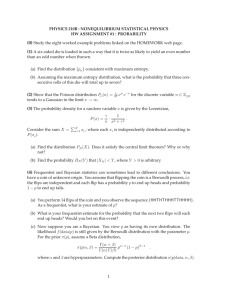
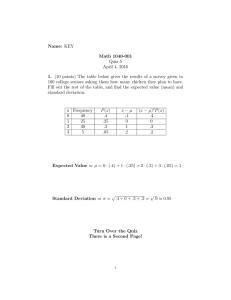


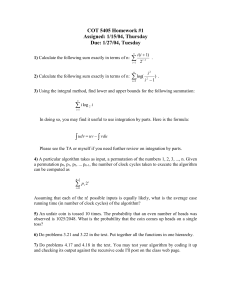
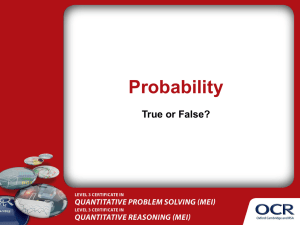
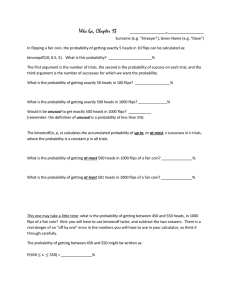
![MA1S12 (Timoney) Tutorial sheet 9a [March 26–31, 2014] Name: Solutions](http://s2.studylib.net/store/data/011008034_1-934d70453529095ae058088c61b34e01-300x300.png)